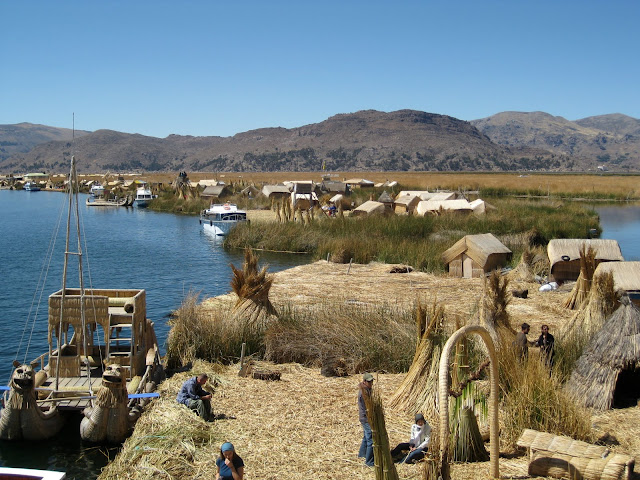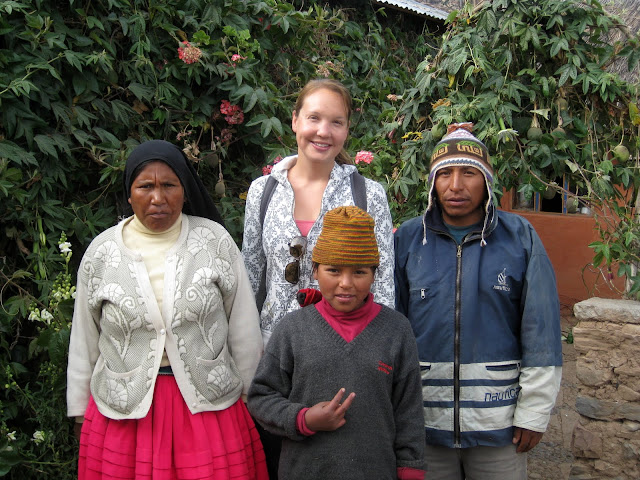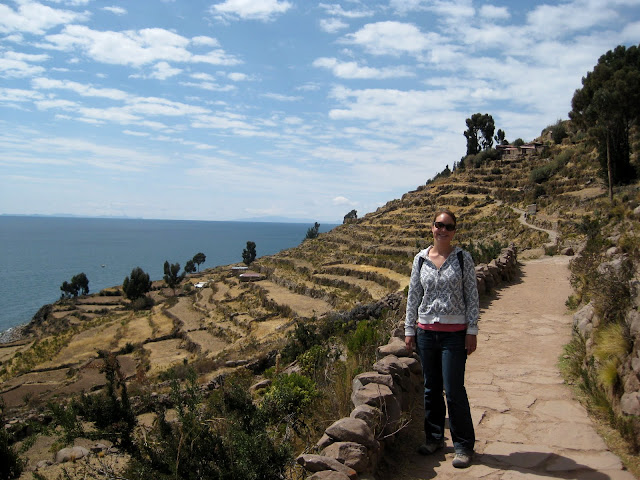Lake Titicaca (like Timbuktu and Kathmandu) is one of those names you hear in your life but are never quite sure if it is an actual place. We were pleasantly pleased to confirm that it is and we enjoyed spending nearly 10 days in and around the lake both on the Peruvian and Bolivian side.
 The access city to the lake from Peru is called Puno. Puno is an intense and busy place for its smaller size, but we quite liked the buzz and as it is a popular tourist town, there were many great restaurants (our favorite being Machu Pizza!) and affordable hostels.
The access city to the lake from Peru is called Puno. Puno is an intense and busy place for its smaller size, but we quite liked the buzz and as it is a popular tourist town, there were many great restaurants (our favorite being Machu Pizza!) and affordable hostels.
The most popular thing to do out of Puno is visit a few of the nearby islands, either on a day-trip or by doing an overnight homestay. We opted for the 2 day/1 night option which allowed us to stay on one of the islands with a family.
Upon departing Puno, nearly all the tourist boats first stop at the Uros floating islands. These islands are both fascinating and sad. Fascinating because they are literally floating through a combination of reeds and reed beds and sad because they are sustained only through mass tourism at this point. In the 1500s, people built and moved to these islands to avoid hostel neighbors and the Spanish invasion that was occurring throughout the region. At one point, these were living and breathing cultures that supported themselves by fishing and trading. However, now the society is a shadow of its former self, with only a small percentage of “islanders” actually living on the islands in huts made of reeds. Their only source of income is through the tourists that are dropped off each day for 30 minutes, and pressure to purchase their handicrafts or take a ride in one of their traditional boats is overt, and somewhat uncomfortable.
 After Uros, the boat continued for another couple hours to the island of Amantani. Upon arriving, Ted and I were assigned to a family (based on a community-organized rotation system). Families look forward to hosting tourists for homestays because it is a significant source of income for small amount of work. Our family was quite lovely, however, our host mother was noticeably offended that Ted and I didn’t wish to purchase any of her homemade hats or scarves that she showed us over lunch. Though I understand that her hope is to sell her items on the few occasions a month that she has the opportunity to host visitors, Ted and I couldn’t help but notice how her attitude towards us after that point changed for the worse. Kinda a bummer.
After Uros, the boat continued for another couple hours to the island of Amantani. Upon arriving, Ted and I were assigned to a family (based on a community-organized rotation system). Families look forward to hosting tourists for homestays because it is a significant source of income for small amount of work. Our family was quite lovely, however, our host mother was noticeably offended that Ted and I didn’t wish to purchase any of her homemade hats or scarves that she showed us over lunch. Though I understand that her hope is to sell her items on the few occasions a month that she has the opportunity to host visitors, Ted and I couldn’t help but notice how her attitude towards us after that point changed for the worse. Kinda a bummer.
We managed to entertain ourselves by exploring the small island by foot and visiting the highest sections of the island and capturing some amazing views and the sunset.
 The next day we traveled to the island of Taquile which is quite close to Amantani. The people of Taquile are known nationwide for their incredible weavings – everything from hats and belts to bracelets and vests. They have a community-organized coop that pools all the work from various artists around the island and the whole island benefits from the tourism and the purchases. Quite impressive indeed!
The next day we traveled to the island of Taquile which is quite close to Amantani. The people of Taquile are known nationwide for their incredible weavings – everything from hats and belts to bracelets and vests. They have a community-organized coop that pools all the work from various artists around the island and the whole island benefits from the tourism and the purchases. Quite impressive indeed!
After a half-day on Taquile, we headed back to dry land for another night in Puno. Though the islands are just a couple hours away by boat, the contrast between the modernity of Puno and the traditional agricultural and artisanal economies of Amantani and Taquile make you feel like you’ve stepped back in time.
